Interviews
Artists Steven Cox and Corey Mason in Conversation
The interview was initially conducted and published by Steven Cox on Hunted Projects, an independant curatorial and interview platform managed by Steven Cox.
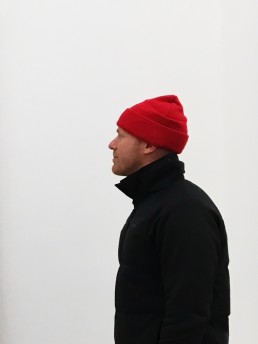
It is the artist’s voice that offers the primary insight into their work. Two artists in conversation are even better. In a series of interviews, artist and curator Steven Cox enters into a dialogue with both internationally emerging and established artists, shedding light on their practices by asking in-depth questions about their path in the art world. Here, Steven gives Corey Mason the floor.
Steven Cox: Can you tell me a little about yourself and your background? Are you working full-time in your studio?
Corey Mason: First of all, thank you for inviting me to be interviewed. My background is a little different than most artists. Growing up in Texas, I had a lawn business and was thus drawn to being outside. When I was researching the school catalog, I decided on landscape architecture and ultimately I got degrees in landscape architecture and agricultural development. These were basically design degrees. I’ve worked on everything from ski resorts to museum parks. What it really taught me, is how to be a great designer. How to see form, shape, color and texture. Sometimes I wish I’d have gone to art school, had I known I wanted to be an “artist”. I do however find it interesting to be on the outside looking in. Am I working full time in the studio? Sure feels like it most days. I do have other sources of income if that’s what you’re asking. I have a wife and three kids and currently enjoy not having the pressure to create art for money. It’s pure passion and personal expression, which brings a lot freedom.
SC: I am curious if you have a daily working routine? Do you have any morning rituals or habits that contribute towards a productive day within the studio?
CM: It’s best described by maybe when I’m not in my studio. I’m constantly mulling over ideas and considering what I want to do next with a piece or idea. So much of the work happens before I get in the studio. It’s hard to describe. But I’d say a lot of the work is done outside the studio – that’s where the challenges are. That’s where the hard work is. Thinking of what the ideas are I want to express, what place I want to come out in a piece or series of works. I take a lot of pictures of the artwork in progress so I can look at them when I’m not in the studio. It helps me process the work and keep things free in the studio. Less thinking. When I get in the studio that’s the fun part because the ideas are already there. There’s less thinking inside the studio. It’s about movement and execution. And there’s always music playing, I don’t know what I’d do without music in the studio. 95% of the time I start in my sketchbook, which is where all the ideas start. It’s quick, it’s easy if you don’t like where it’s going – just turn the page. It’s super fast. I want the larger pieces to have this immediacy. It’s something I’m working on. I’m not there yet.
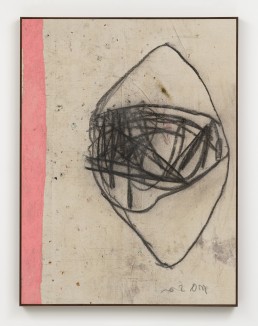
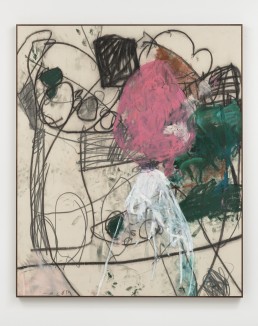
SC: Can you please tell me about your studio set up? Would you say that your current studio is ideal, or are you seeking a larger/better space?
CM: My studio is great because it’s so convenient – it’s a separate building behind my house. I do wish it was bigger and hopefully we can add on later this year. But having it so close to my house makes it so much more accessible to create.
SC: To what extent do you consider your city as being an influential factor in the shaping of your work? Do you feel that your surroundings have influenced you in one way or another?
CM: These are great questions. I’d say the cities I’ve been to and visited have more influence in shaping the work versus Raleigh, North Carolina. It’s not that Raleigh doesn’t have something to offer. It’s that my work is often times more about exploration of the past. I’m fascinated by history and the thought of unearthing something that no one knew before. Like an old Spanish explorer discovering a remote island. For example, in 2005 I went on a botany trip to the mountains of Northern Mexico. We were searching for rare Oak acorns to give as gifts to the Royal Oak Society in England. This trip had a profound impact on my life and work. I just remember seeing the high desert dirt and fields of yucca. It created a real interest in Mexican icons. I’d say vessel paintings are the most direct sign of this influence.
SC: I am interested to know how you plan your works. You said you make a lot of sketches outside of the studio, but maybe you could tell me your thoughts when it comes to transferring these ideas and sketches onto canvas. Do you aim to make direct recreations of your sketches onto canvas? Also, to what extent does improvisation play in your painting?
CM: In some cases I’ve tried to make a direct representation from the scratching in the sketchbook. But more often than not I’m painting on a large scale from memory. Through repetition or continually drawing an idea that way when I move to the larger scale it’s more familiar. I believe it’s important that a painting has a sense of spontaneity and immediacy.
"I believe it's important that a painting has a sense of spontaneity and immediacy"
SC: When viewing your work, it appears that the element of drawing is paramount within your works, with the application of paint being secondary. Do you feel that one element is more important than the other? Is balance something you consider?
CM: I think drawing is certainly, maybe not more important, but certainly Paramount as you described. Paint is used to balance the idea. It’s almost like a highlighter, a way to draw attention. For me, that’s really the role.
SC: How would describe your work to someone?
CM: People ask me this often but I still have no idea.
SC: I am interested in the notion of preciousness and at what stage a painting or work becomes discarded in the studio. Do you have a tendency to destroy failed paintings/works?
CM: I have no problems throwing stuff away. If it’s bad it’s bad and it will never be good. The quicker you can give up on something, the more time you have for the next idea. So there are lots of bad things all over the studio floor.
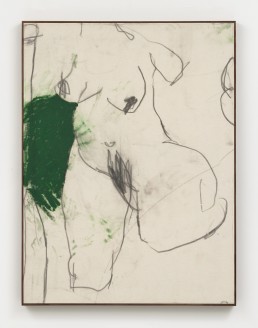
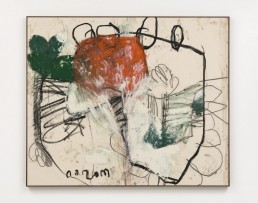
SC: You said earlier that you regularly take images of your works in progress so you can study these images at a later time. Maybe you could tell me a little more about the importance of this process for your way of working…
CM: Yes, I do this because I can’t spend 24 hours a day in the studio staring at the work. So it’s a way of taking it with me and then in idle time looking at a piece. I think, in large part, I use it as a way to decide whether I like a piece or not. It creates space or distance from the painting, which helps me make decisions.
SC: Could you tell me about the works of yours that are currently in progress in your studio?
CM: Currently I’m working on these “wallpaper” paintings, at least that’s what I’m calling them at the moment. They feel a little bit more like scenes from a jungle or something like that. There’s a flatness to them that I like.
SC: Do you have plans to exhibit this new series of works in 2018?
CM: I have no plans at the moment. These are just for me something I’m exploring. They are very different so they might wind up on the studio floor or in the trash. But who knows.
SC: What are some of the key items or art materials that you always need to have close to hand?
CM: 9B graphite stick and a sketchbook with cream’ish paper. I can’t stand a bright white.
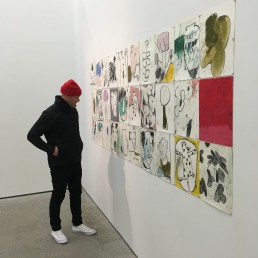
SC: Can you highlight some of your influences and discuss how your influences have made an impact on you and your practice?
CM: I guess I’d have to say Twombly and Picasso. For the most part their work always seem to be derived from the practice of drawing and I’m obviously attracted to that. There’s timelessness in their work that I’m attracted to – something I’m continually trying to do. A measure of success in a way. Something old that also feels modern.
SC: What future exhibitions do you have scheduled?
CM: I have an exhibition planned at Olsen Gruin gallery in New York set for November. I’m also working on a solo with FIFI Projects in Mexico City
SC: In relation to social media and more specifically Instagram, what are your thoughts on this as a platform to engage with new audiences? Do you have a love/hate relationship with Instagram or other online social media platforms?
CM: Oh Instagram. I see it as a pretty valuable tool and I do have a love-hate relationship with it but I think it’s more positive than negative. I mean I can see exhibitions going on all over the world without getting on a plane. That’s pretty amazing. The amount of art you can see in a day is incredible. But it does come with drawbacks of course. It’s obviously a bit one-dimensional – you don’t really get the feel of a piece until you see it in person and that’s the unfortunate part of only looking at something digitally. But I’m much more in the camp of seeing something than not seeing it out at all. And to add to that, I’m not sure or let me say it this way… I think it would have taken me a lot more time to create the connections I’ve created without Instagram. I mean how would we have met? So I think it’s great overall. But I do hate the need to be on there.
SC: Do you consider Instagram important for artists working today?
CM: I believe it’s an important tool for artists. It’s not essential for sure but every artist has to figure out a way to market themselves. It just doesn’t have to be on Instagram.
About Hunted Projects
Hunted Projects is an independant curatorial and interview platform managed by Steven Cox. For all enquiries, please contact: stevencox@huntedprojects.com
More information here.